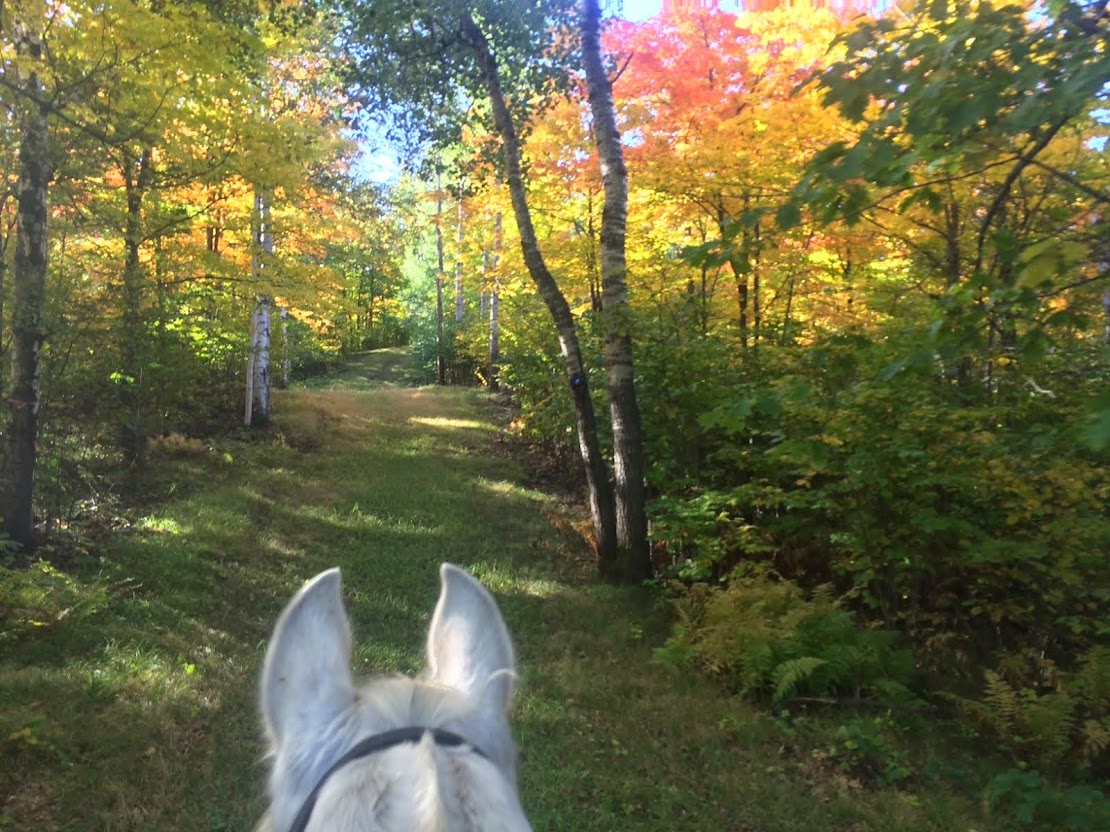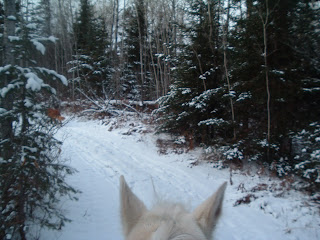I live in northern Minnesota. We have a lot of winter. I ride all winter, outside on trails as much as I can. So, you may wonder, how does one ride a horse in the winter in MN and stay warm? Well, it depends on the weather, of course!
This day's ride (December 13, 2009) was a very pleasant one. I typically find that I am quite comfortable for about 45 minutes of mostly walking. It was about 5 degrees above zero and sunny, with a light wind (so I'd estimate a wind chill around -15 to -20) - this would be a fairly typical winter ride. I do a lot of just walking in the winter for two main reasons; one, I try to avoid getting my horses sweaty when it's less than about 20 degrees, and, two, the footing (read: snow drifts) often demands it.
Start dressing with a good base layer. This is your most important layer - it must wick. If you get soggy, you will be cold. I guarantee it! So, I start with wicking long underwear; my favorite for riding is polypro, but I also sometimes wear silk for warmer days. I use liner socks as well, either silk or polypro. Then a polarfleece turtleneck. This completes layer 1.
The middle layer needs to be insulating, but still able to wick. Remember, moisture next to your skin is your enemy when dressing for cold weather activities! This ride, I wore my double layer winter riding tights from Kerrits ( http://www.kerrits.com/ ), which have a layer of polarfleece on the interior and some sort of wind blocking smooth material on the outside. I love these tights! Also a thin but dense polarfleece zip-neck pullover and a polarfleece vest for my upper body. My second layer of socks is Smartwool ( https://www.smartwool.com/default.cfm ) heavy weight trekking socks. It's very important to make sure your toes can still wiggle in your boots with your chosen sock layers - if your socks make your boots too tight, you will get cold feet.
Finally, your outer layer should be wind- and water-proof, but also breathable. I'll mention it one more time: moisture trapped next to your skin makes you cold! For this ride, I wore my very old and very broken in Carhartt insulated overalls and a very old Columbia 3-in-1 winter jacket which has an insulated zip-out layer plus the outer wind- and water-proof layer. I have the best boots in the world - Steger Mukluks ( http://www.mukluks.com/ ). Mine are knee-high wool blanket topped mukluks, which have a dense wool felt liner. Add a polarfleece neck warmer (navy blue in the photo), a thin polarfleece hat (brighter blue in the photo) which squishes reasonably well under my helmet, my polarfleece helmet cover with built-in neck gaiter, and a pair of REI ski mittens, and I'm set!
So, if you go back and count, I am wearing 3 layers of polarfleece on my upper body, plus 3 layers of polarfleece on my head & neck. Now that's what I'm talking about! I won't admit how much polarfleece I actually own, but let's just say I'm still looking for a polarfleece bra to add to my collection.
Now, for you horsey types reading this, you may notice a problem with this attire. How the heck will I fit my butt in the saddle or my feet in the stirrups? Well, I don't. I ride most of the winter in a suede El Companero ( http://www.elcompanero.com/ ) bareback pad. It's really comfy & secure, my horses seem to love it, and it allows me to share my horse's considerable body heat. I do have to find something tall to stand on to mount. It's usually much less than graceful. I've found snowbanks useful if they're packed enough, otherwise they provide much comic relief as I land laughing on my ass beside or beneath the poor horse - luckily my boys are quite tolerant of this! Also, since my pad is bright turquoise and my Carhartts are very faded, I end up with a turquoise "blush" on my inner thighs & butt when I'm done riding. These are small prices to pay, I feel, for a warm & secure ride.
Here, Rhio models the El Companero after our ride. Another benefit to this style of winter riding - it hardly takes any time at all to tack up and I don't have to take my mittens off! Rhio usually goes in a hackamore, but I am starting him back in a bit this winter (more on this in future posts) - so there may be a few extra minutes of bit-warming before tacking up. Again, I'm very grateful to have a heated tack room!
We rode our home trails for this ride. This is my most common winter riding ground. The roads around the farm become snow- and ice-packed early in the winter and this layer does not begin to disappear until late February or early March in a good year, so I am limited to on-property rides. The coldest part is the alleyway between pastures and the hayfield, where the wind can really kick up & chill what exposed skin you have left (eyeballs are about all I have exposed!) - but the trails are wooded and thus protected from the wind.
Last parting advice if you want to ride in winter - go to the bathroom before you dress in all your layers! It's a real pain to have to peel them off if nature calls.






Phil says you have just talked a lot of people out of going north, Taryn!
ReplyDeleteConnie
A polarfleece bra...now that would be luxury!
ReplyDeleteWell, if you can't take the cold, don't visit the ice box, I say! And, yes, a polarfleece bra would be heavenly...I've never seen one but I'm always on the lookout!
ReplyDelete